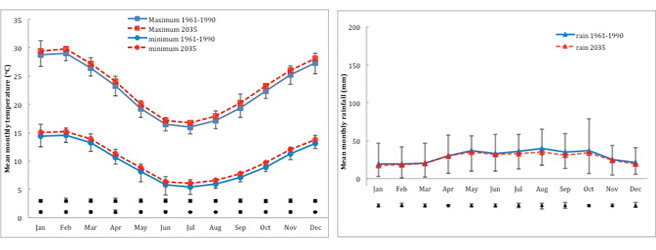Changes in temperature and rainfall
Although maximum and minimum temperatures are projected to undergo a comparatively moderate increase of 0.5-1.1°C by 2035, the major climate impact on Murray Bridge will be on extreme temperatures. Days over 40C will increase from 2.3-3.6 days annually, while runs of 3-5 days in such high temperatures will start to occur. As with Werribee, the major decline in rainfall is likely to occur during spring, with decreases of 6-21% predicted.
Potential effects on crops
- Increases in summer temperatures, particularly the increases in extremes, will impact on summer crops
- The potential and expected increase in the frost window may have significant implications for the Murray Bridge region, especially as warm temperatures encourage susceptible young growth
- Predictions for Murray water availability in 2035 are less severe than those experienced in the recent drought. During 1997-2006 surface water availability declined by 30%. The best estimate for 2035 is a 14% reduction in surface water availability
Click HERE for a table showing the effects of changes in average temperature of +1oC, +2oC, +3oC, +4oC as well as the impact of 5 days over 35oC for major crops grown in Murray Bridge.
Note : These descriptions relate to the temperatures that the crops experience and not to changes in monthly average temperatures. An increase of 1oC in monthly average temperature can easily mean increases of 4oC or more on particular days.
